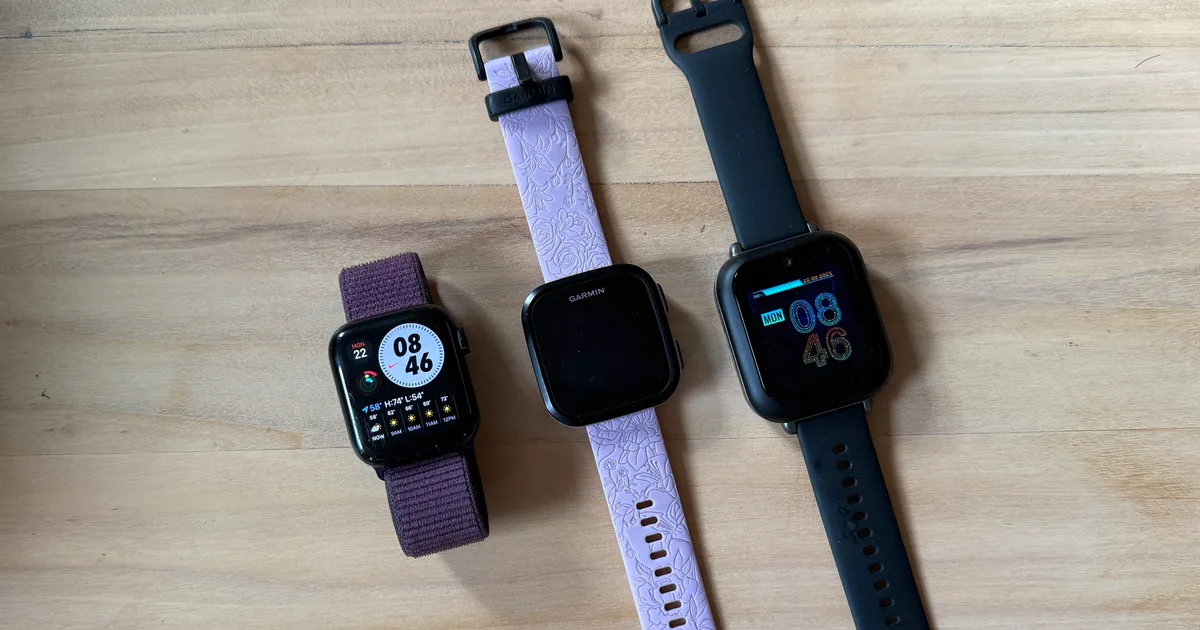
As a parent of newly minted third- and fifth-graders who has worked in children’s technology and media for 20 years, I’ve watched as the conversation around smart devices has become ubiquitous on the playground and in group chats. What’s the right age to get one? How does one balance autonomy and safety? How does a kid stay in touch while staying offline? How does one make sure the child is invested enough to keep track of the device but not so into it that they’re on it all day?
I wanted to understand how parents of kids in the later elementary years and middle school are navigating these questions, particularly those who’ve decided to start their kids’ foray into technology with a smartwatch. These have become an increasingly popular option to buy before fully committing to a smartphone — and as schools around the country institute bans on using various devices during the school day.
To find out which functionalities parents and kids wanted from these watches and what kinds of experiences they’ve had with them, I talked to nine families with kids ranging from 7 to 12, all of whom currently use smartwatches. For younger kids (under 10), the most important requirement for most families was finding a watch that would allow rudimentary communication between the child and parents to enable more independence. Parents wanted to let kids walk to and from school and go out with friends in the neighborhood or have a way to communicate changing logistics while being able to keep in touch in case of emergencies or safety needs. At the same time, they were adamant that kids not have too much access to social media, websites, games, or group chats and that the phone not be a distraction.
I also personally tested five of the most popular smartwatch options with my own 7- and 9-year-olds. They vary widely in restrictiveness, functionality, and ease of setup and use. Some, for example, support geofencing: You can set up safe zones in an app, which will then send you notifications when your kid enters or exits those areas. Even among those, there are differing levels of usefulness. I’ve highlighted the important features and the pros and cons of each below.
New! You can now save this product for later.
Features
Location tracking: Real-time tracking and geofencing
Emergency SOS: Yes
Internet: No
Games: Yes, very rudimentary
Camera: No, but available on the Watch 3 (non-Adventure model)
Fitness tracking: Yes
Only approved contacts can call or text: Yes, by default
Approved contacts must have app to send messages: Yes
What we like
• Limited functionality for kids
What we don’t like
• Communication limited to preset texts and recorded audio
• App is clunky
Cost
$35 activation fee + $10/month for service
The Verizon Gizmo is a popular starter watch because of the controls it gives parents and the limited functionality for kids; it’s also the watch families tend to choose if they already have other devices on Verizon. The flipside of the limited functionality, however, is that many families eventually trade up to an Apple Watch as their kids gain more independence.
The Gizmo was one of the watches I tried that required the least amount of setup for parental controls, mostly because the functionality is so limited to start with. “I wanted the most restrictive and locked-down version of a phone and tracking device for my child,” said Amy Kilbane, mom to 9-and-a-half-year-old Reese. “It was important to me that she could call and text her parents and grandparents. I wanted a very limited number of people who could be programmed in for her to call.”
Rachel Brantley, mom to 9-year-old Camille, also likes the Gizmo primarily because of how limited it is, while finding it technically reliable for their needs: “We liked the fact that only we can input the contacts, and she’s only able to text us, not everyone in her contact list.” For both mothers, the goal was for their kids to use the watches only when completely necessary, not for chatting with friends or as a distraction.
Megan Spencer initially got her son, Dylan, a Gizmo when he was 9 (he’s now 11) but switched to an Apple Watch later because of the Gizmo’s limitations. “I could only access Gizmo through their proprietary app, which was clunky and never worked correctly and crashed frequently,” she said. “It’s not like making a phone call with an actual phone. I had to go through multiple menus to get to the option to call him on that app.”
Spencer also noted one major drawback in how the Gizmo’s notifications work: “In order for him to contact people other than me, they had to have that app too, and I had to grant the other contacts full access. As a result, family members would get an alert whenever I took my kid somewhere.”
New! You can now save this product for later.
Features
Location tracking: Real-time tracking and geofencing
Emergency SOS: Yes
Internet: No
Games: No
Camera: Yes
Fitness tracking: Yes
Only approved contacts can call or text: Yes, by default
Approved contacts must have app to send messages: No
What we like
• Extensive content monitoring
• Can make video calls
What we don’t like
• Excessive content monitoring
• Setup is unintuitive and can be challenging
• App is confusing and clunky
• Keyboard makes texting difficult
Cost
No activation fee, $22/month ($7/month for 24 months for watch + $15/month, month-to-month, for service)
I received a sample of the Bark watch, which positions itself as a distraction-free, safety-first device with strong parental controls. Its product messaging focuses on children’s safety and monitoring, and parents who are particularly concerned about bullying, tracking their child’s location, and providing high oversight may be most interested in this option.
Off the bat, I experienced numerous setup challenges: The watch would not text or call even when it claimed it was set up with my 9-year-old’s account, leading to hours of back-and-forth with customer support before I was eventually sent a replacement. The second setup was smoother but still required customer support to navigate the options despite my being among the more tech-savvy parents in my peer group.
Another aspect of confusion is the two Bark apps: One is a companion app for parents; the other is the kids’ app for the kid-friendly phones the brand offers. I downloaded both, not realizing one was intended for children and for a device I’m not using. The kids’ app has an extremely slow VPN designed to reduce internet speed for kids, but it had the unintended result of slowing down my own iPhone. The parent app is intended to support a suite of Bark products, not just the watch, so in addition to features like location tracking and alerts management, it offers website blocking, screen-time management, and social-media controls, which aren’t relevant to the watch.
On the parental side, the degree of advanced content monitoring feels excessive. The watch offers built-in software that scans texts, photos, and videos for signs of bullying or inappropriate content — and notifies parents immediately through a series of alerts. The default settings are on the more sensitive side. For some, this may be a pro, but I found the number of alerts and settings pertaining to bullying, suicide, and violence less pertinent to my own kids, and it seemed as if the company were coming from a perspective of fearmongering rather than building trust.
On a purely functional level, my kids found the style of the keyboard — a full QWERTY squeezed into the 1.6-inch display — extremely hard to type on compared with other watches. They relied more heavily on voice texting or just sending each other emoji, which discouraged their overall use of the watch.
Of the watches listed here, the Bark is the only one that offers what amounts to a trial period: If you cancel the contract within 60 days, you can return the watch. And because there’s no activation fee and you don’t pay for the watch upfront, it has the lowest initial cost among those I considered.
New! You can now save this product for later.
Features
Location tracking: Yes, with geofencing (but see below)
Emergency SOS: Yes
Internet: No
Games: Yes, but limited
Camera: No
Fitness tracking: Yes
Only approved contacts can call or text: Yes, by default
Approved contacts must have app to send messages: No
What we like
• Flexible communication options
• Limited functionality for kids
What we don’t like
• Imprecise location tracking
Cost
$30 activation fee + $13/month (two-year contract), $15/month (one-year contract), or $18/month (month-to-month) for service plans
The Gabb Watch is another limited-functionality option parents told me they liked. “Lack was the key for us: no internet access, limited games. We really just wanted a device she could contact us from via voice or text,” said Tiya Gordon, mom of 10-year-old Bejla.
You receive your own phone number when you sign up for a Gabb subscription plan. Parents need to approve contacts, but you can easily message the watch directly from a variety of devices.
My 9-year-old daughter said she liked the Gabb over other options we tried because she could make phone calls and voice-to-text messages to communicate with her approved contacts, rather than send only audio or preset messages (as with the Garmin Bounce, reviewed below). This allowed her to communicate with me and her dad on our iPhones and her friends on other devices without these contacts needing to have a proprietary app.
As with the other watches we tried, the Gabb offers fitness tracking, a handful of wallpaper customization options, and some limited-functionality games my kids checked out once before forgetting.
One area I found frustrating was the wide coverage of the geofencing. This feature allows a parent to set boundaries around certain locations, and the watch then sends a notification to the parent when the child enters or exits the designated zone. Unfortunately, the minimum diameter for the circular zones you can set is about four-to-six city blocks wide. So if the designated zones are close together, the app will send you messages even when the kid has not reached their destination, which can lead to a lot of false positives.
New! You can now save this product for later.
Features
Location tracking: Real-time tracking and geofencing
Emergency SOS: Yes
Internet: No
Games: Yes, but limited
Camera: No
Fitness tracking: Yes
Only approved contacts can call or text: Yes, by default
Approved contacts must have app to send messages: Yes, or a Garmin device
What we like
• Accurate location tracking
What we don’t like
• Limited to communicating with users of Garmin devices or app
• Can send and receive only audio messages and (customizable) preset texts and emoji
Cost
No activation fee, $10 monthly or $100 annual subscription plan
The Garmin Bounce is another strong option for younger kids, for whom limited functionality can be a boon, while allowing them to communicate with parents and other approved contacts. Like the Gizmo, Bark, and Gabb, the Bounce requires parents to download a separate app to manage watch settings and controls, such as establishing safe zones, approving contacts, and managing preset texts. Parents can also set daily goals with the app’s chore and reward tracking feature.
Because the Bounce allows messaging only with contacts who are also on the Garmin app, it tends to be preferable when friends or other family members already have Garmin devices. This was the case in my 9-year-old daughter’s friend group; several friends got Garmins, and other kids were excited by the option of communicating with one another. Communication is limited to two-way voice messaging, and, for the kid, responding to texts with preset messages or emoji.
For those using the watch purely for limited communication and safety-oriented tracking, the Bounce is a great option. “We are quite strict, and he knows he can only use the watch for walking to school or soccer practice,” said Michaella Solar-March. I also found the Bounce had a much more precise ability to detect when my kids arrived at or departed from a particular location, giving me the peace of mind I wanted from the location features.
New! You can now save this product for later.
Features
Location tracking: Real-time tracking and geofencing
Emergency SOS: Yes
Internet: Yes
Games: Yes
Camera: No
Fitness tracking: Yes
Only approved contacts can call or text: Yes, but opt-in
Approved contacts must have app to send messages: No
What we like
• Easy setup for families in Apple’s ecosystem
• Most robust functionality
• Increasing functionality can be unlocked gradually
What we don’t like
• More setup required for controls
• Must have iPhone to set up watch
Cost
About $10/month (varies according to carrier, may be less on an annual plan)
The Apple Watch SE was the undisputed smartwatch pick for kids entering middle school and up. The parents I spoke to liked the overall ease of setup with other Apple devices in the household, the ability for their kids to text and call friends and family without needing to use a separate app, the option to connect to parent-approved apps like music streaming, Apple Health, watch-face customization options, and group chatting, and a wide range of functionality a kid can grow into, like access to Siri. The Apple Watch was also the most desirable to kids, offering more social cachet, not seeming babyish, and aging up with the user. Parents can release more functionality over time, so in many cases, this device has a longer potential lifespan. It’s hard to get around the strong pull of the ecosystem, too. “In the end, the Apple Watch won out because we are an Apple family and it integrated seamlessly with existing devices at home with minimal learning curve for us parents,” said Liz Kim, mom to 10-year-old Scottie.
Molly Wizenberg appreciates the independence the Apple Watch gives her 12-year-old, as well as how it lets her keep an eye on them just in case. “The watch has made them an enthusiastic bus rider because they can listen to music on the bus and can text me any time they need to,” she said. “I can see their location, which makes us all feel secure as they bus around and explore neighborhoods, go to bookstores, etc.”
Since Apple Watches aren’t designed specifically for children, there’s no built-in companion app explicitly designed for monitoring a kid’s use or location. Instead, parents can opt into parental controls with the iPhone they used to set up the watch. Using the Apple Watch app and Screen Time, they can set up approved contacts, time limits, content monitoring, and access to apps. (Location Tracking can be set up through Find My.) “His watch charger is in our common area so it doesn’t distract from his sleep, and I will occasionally look through his messages to check for anything not okay,” says Megan McConnell, mom to 11-year-old Dylan. She makes good use of the Schooltime function, which locks down the watch on a designated schedule, even at summer camp.
More From The Strategist
I’m Extremely Picky About My Pens. After Years of Testing, I Have 10 Favorites.
So You’re Looking to Outfit Your Kitchen From Scratch …
The Strategist Fall 100
What Sally Jessy Raphael Can’t Live Without
See All



